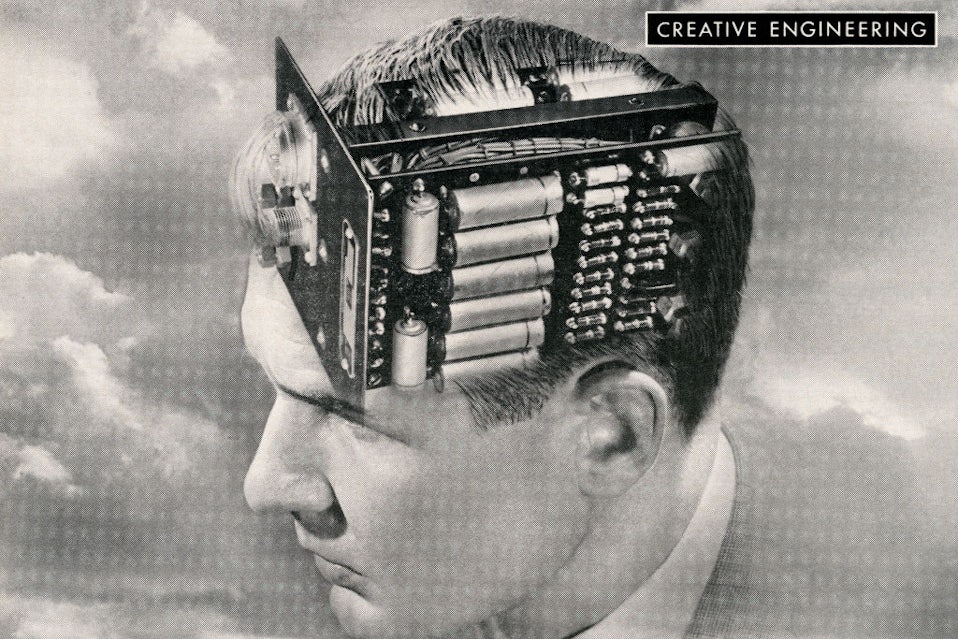


You are currently logged on to the largest version of the internet that has ever existed. By clicking and scrolling, you’re one of the 5 billion–plus people contributing to an unfathomable array of networked information—quintillions of bytes produced each day.
The sprawl has become disorienting. Some of my peers in the media have written about how the internet has started to feel “placeless” and more ephemeral, even like it is “evaporating.” Perhaps this is because, as my colleague Ian Bogost has argued, “the age of social media is ending,” and there is no clear replacement. Or maybe artificial intelligence is flooding the internet with synthetic information and killing the old web. Behind these theories is the same general perception: Understanding what is actually happening online has become harder than ever.
The internet destroyed any idea of a monoculture long ago, but new complications cloud the online ecosystem today: TikTok’s opaque “For You” recommendation system, the ascension of paywalls that limit access to websites such as this one, the collapse of Twitter—now X—under Elon Musk, the waning relevance of news across most social-media sites. The broad effect is an online experience that feels unique to every individual, depending on their ideologies and browsing habits. The very idea of popularity is up for debate: Is that trend really viral? Did everyone see that post, or is it just my little corner of the internet? More than before, it feels like we’re holding a fun-house mirror up to the internet and struggling to make sense of the distorted picture.
Read the rest of this article at: The Atlantic
Stop me if these gripes sound familiar. In 2023, the idea that the internet isn’t fun anymore is conventional wisdom. This year, after Elon Musk renamed Twitter “X” and instituted a series of berserk changes that made it substantially less functional, complaints about the demise of the good internet popped up like mushrooms sprouting in dirt tossed over a fresh grave. Some people even complained on the very platforms they were mourning. Type “internet sucks now” into X’s search bar, you’ll see.
The New Yorker published an essay by writer Kyle Chayka on the subject, calling the decline of X a “bellwether for a new era of the Internet that simply feels less fun than it used to be.” People loved it. (Sample comments from X: “Relatable.” “Exactly right.”) Chayka claims that it’s now harder to find new memes, websites, and browser games than it was a decade ago. He also argues that the rising crop of platforms popular with young people—Twitch, TikTok—are inferior, enjoyment-wise, to the social web of the 2010s.
Both of these arguments are baffling. Memes fresher in the past? Yes, it’s tiresome to see Tim Robinson in a hot dog costume for the 500th time, but c’mon. In the early 2010s—the years Chayka longs for—the internet was all doge and doggos. It was the era of reaction GIF Tumblrs, the Harlem Shake, the Ice Bucket Challenge. Give me literally any still from I Think You Should Leave over “You Had One Job” epic fail image macros. Only glasses of the rosiest tint could recast the 2013 internet as a shitposting paradise lost.
Read the rest of this article at: Wired
Before screens, tipping, like a marriage proposal, was a private affair. Tips can reveal hidden values or the rumblings of the subconscious. A waitress’s breast size, for instance, correlates positively with tip size. “Mad Men”-era husbands tipped more when dining with someone else’s wife than with their own. The grief-inflected gratitude of the post-pandemic period introduced new tipping behaviors. Etiquette experts studied the so-called guilt-tip boom. The gratuity, like everything else, has gone contactless—the swivelling of the iPad. In the past three years, according to data from the payroll company Gusto, tips in bakeries and cafés are up forty-one per cent. Apparently, we now tip assistant sports coaches (up three hundred and sixty-seven per cent) and theatre-box-office staff (up a hundred and sixty-one per cent). Do you tip the cashier when all she’s done is ring up your salad? Don’t, and you’re a cheapskate. Do, and you’re a sucker. Where before you scribbled a tip in the candlelit darkness of a restaurant, now you do it in the spotlight glow of the screen. The polite thing to do, standing in line, is to behave as you would at the A.T.M., or the urinal: look away.
Recently, I spoke with Michael Reed, a butcher at Bob’s Quality Meats, a shop in Seattle. “It’s a field where it’s not customary to tip,” he told me, on his day off. Reed has worked in what he calls “retail meat” for twenty years. It’s more occupation than passion, but he’s proud of the personal touches in his butchery. Immigrants describe, and receive, home-country cuts that don’t have English names. Reed knows which customers have bad teeth, and he slices their steaks thin. In 2021, Bob’s installed a new checkout system: the swivelling tablet. The shop set its own tipping options—from three per cent to ten per cent. “I didn’t think it would generate a significant amount,” Reed said. “I turned out to be wrong.”
Read the rest of this article at: The New Yorker
This March, news broke that the latest artificial intelligence models could pass the LSAT, SAT, and AP exams. It sparked another round of A.I. panic. The machines, it seemed, were already at peak human ability. Around that time, I conducted my own, more modest test. I asked a couple of A.I. programs to “write a six-word story about baby shoes,” riffing on the famous (if apocryphal) Hemingway story. They failed but not in the way I expected. Bard gave me five words, and ChatGPT produced eight. I tried again, specifying “exactly six words,” and received eight and then four words. What did it mean that A.I. could best top-tier lawyers yet fail preschool math?
A year since the launch of ChatGPT, I wonder if the answer isn’t just what it seems: A.I. is simultaneously impressive and pretty dumb. Maybe not as dumb as the NFT apes or Zuckerberg’s Metaverse cubicle simulator, which Silicon Valley also promised would revolutionize all aspects of life. But at least half-dumb. One day A.I. passes the bar exam, and the next, lawyers are being fined for citing A.I.-invented laws. One second it’s “the end of writing,” the next it’s recommending recipes for “mosquito-repellant roast potatoes.” At best, A.I. is a mixed bag. (Since “artificial intelligence” is an intentionally vague term, I should specify I’m discussing “generative A.I.” programs like ChatGPT and MidJourney that create text, images, and audio. Credit where credit is due: Branding unthinking, error-prone algorithms as “artificial intelligence” was a brilliant marketing coup.)
The flaws are amusing and a relief to many artists who—when ChatGPT was released—feared their profession might be over. If a computer program could produce a novel or painting at the press of a button, why were we spending countless hours torturing ourselves in cafés and studios for little recognition and even less pay? Yet as the limitations became apparent, artists’ despair was replaced with anger. Visual artists learned A.I. was being used to copy their work. Actors realized Hollywood studios wanted to use A.I. recreations of them for eternity. And authors discovered their books had been pirated by corporations whose billionaire investors cried poverty at the suggestion they should pay even a penny in compensation. Artists’ anger turned to strikes and lawsuits.
The legal questions will be settled in court, and the discourse tends to get bogged down in semantic debates about “plagiarism” and “originality,” but the essential truth of A.I. is clear: The largest corporations on earth ripped off generations of artists without permission or compensation to produce programs meant to rip us off even more.
Read the rest of this article at: The New Republic
I. A Small Earthquake
At 2:03 a.m. on Monday, September 26, 2022, at the bottom of the Baltic Sea, an explosion tore open one of the four massive underwater conduits that make up the Nord Stream pipeline. The pipe, made of thick, concrete-encased steel, lay at a depth of 260 feet. It was filled with highly compressed methane gas.
Pressure readings would show a sudden plunge as compressed gas screamed through the breach at the speed of sound, tearing the pipe apart and carving deep craters on the seafloor. Gas escaped with enough force to propel a rocket into space. It shot up and up, creating a towering geyser above the surface of the water.
There was no one in the vicinity—the middle of the sea in the middle of the night—to see or hear any of this, but the event registered with the force of a small earthquake on seismometers 15 miles away, on the Danish island of Bornholm. Because the explosion had occurred in Danish waters, Denmark dispatched an airplane to investigate. By then, the geyser had settled into a wide, turbulent simmer on the surface. The Danish Maritime Authority ordered ships to steer clear. Airspace was restricted. A pipeline executive in Switzerland, where Nord Stream is based, urgently exchanged information with officials in Denmark and other countries.
Nord Stream had been built in two phases, NS-1 and NS-2, each consisting of two pipes labeled A and B. The pipes, with an internal diameter of about four feet, reached across 760 miles of seafloor from Russia to Germany. Given the pressure readings and the location of the surface turbulence, the ruptured pipe appeared to be NS-2A.
No one knew yet what had happened. There were innocent explanations—none of them likely, but some certainly plausible. The pipeline may have sprung a leak on its own. Or some accident or natural event may have disturbed the sea bottom. The area around Bornholm is prone to small earthquakes, and the Baltic Sea is littered with explosive debris. It was heavily mined during the Second World War and, at war’s end, became a dumping ground for unused munitions. Efforts to clear the seabed continue, and live ordnance is often detonated in place. Fishing vessels trawl the bottom—sometimes leaving scratches on the surface of pipelines—and occasionally set off an old mine or bomb. On a typical day, Swedish seismologists detect dozens of underwater explosions, some accidental, some deliberate. But the Nord Stream pipes were built to withstand such blasts and had been placed in lanes painstakingly cleared of hazards.
Read the rest of this article at: The Atlantic




